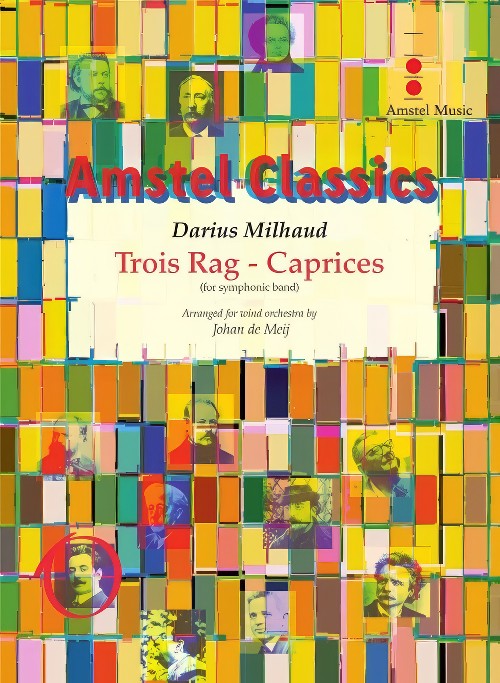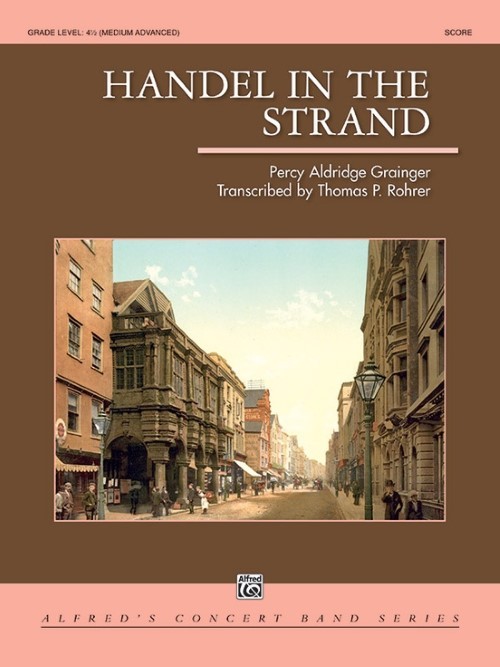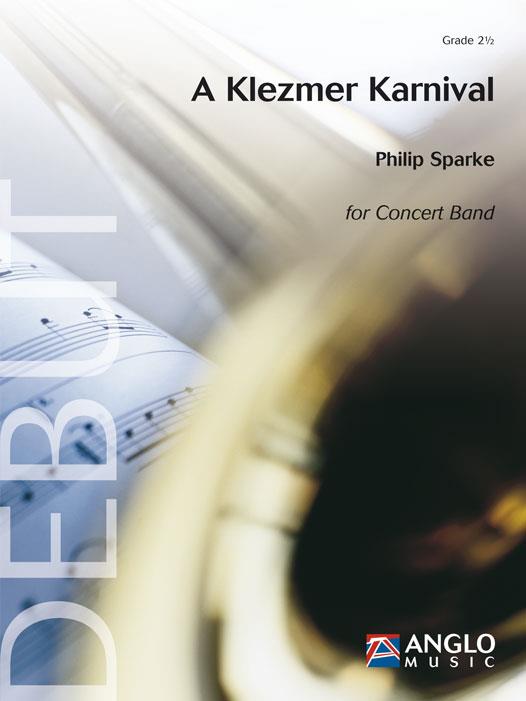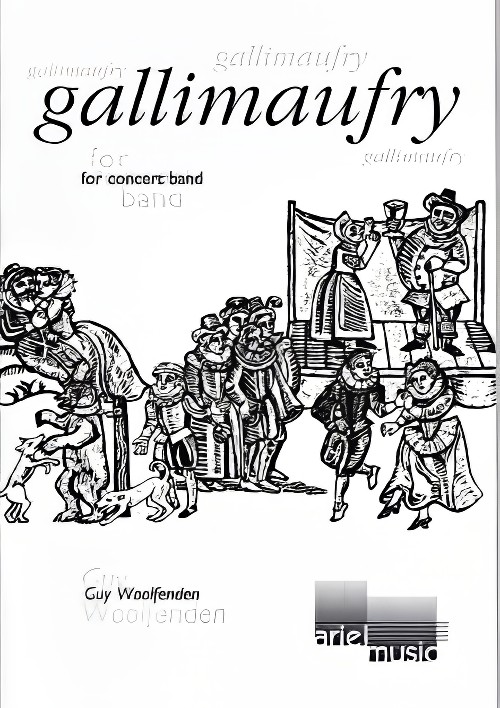Results
-
 £137.99
£137.99The Gipsy Baron Wind Band Set (Score & Parts)
The operetta The Gipsy Baron is, together with Die Fledermaus (The Bat), the most famous theatre work by Johann Strauss Jr. A libretto full of romance, original musical ideas, compelling Viennese dances, fiery rhythmic Hungarian music and beautiful arias, were just some of the ingredients that lead to its huge success. The Gipsy Baron can also be thought of as a comic opera. The main motif of this overture won first prize in a contest that was to provide a new Hungarian anthem, however because Strauss did not have Hungarian nationality, another melody was chosen. A great transcription to bring a Hungarian twist to any programme. 0:08:15
Estimated dispatch 7-14 working days
-
 £252.10
£252.10Norsk Festouverture - Johan Halvorsen
The Norwegian Festival Overture was written for the grand opening of the National Theatre on September 1st, 1899. In the opening bars, one can virtually imagine the stage curtain being drawn aside, and the stage is revealed to the audience. The trumpets openly quote Peer Gynts return from Grieg's music to the play Peer Gynt. The main part of the overture consists of a theme in Norwegian folk music style, which Halvorsen brilliantly develops thematically and contrapuntally. The work can probably be seen as pompous and at times seems somewhat overwrought, but then Halvorsen himself, ever so slightly self-deprecating, has written Pomposo over the grand conclusion of the work.The arrangement of the overture was written to The Royal Norwegian Navy Band for a concert in Halvorsen's native town of Drammen in 2016. The arranger has tried to preserve as much as possible of Halvorsen's brilliant orchestration. There are a lot of cue notes which make it possible to perform also with a reduced instrumentation.
Estimated dispatch 7-14 working days
-
 £174.10
£174.10Bnder i Byen (Fra Smbyskisser) - Sverre Bergh
Sverre Bergh (1915-1980) was a central character in the music scene in Bergen, both as a musical leader at "Den Nationale Scene" (theatre) and as a director for the "Festspillene" music festival. He was an arranger and pianist for the NorwegianBroadcasting Company (NRK), and wrote stage- and film scores as well as piano pieces. "Country-Folk in Town" is one movement from "Village Sketches". This small overture was written for the Bergen Philharmonic Orchestra.
Estimated dispatch 7-14 working days
-
£154.60
Marcia - Dag Ivar Wiren
Dag Wirn (1905 1986) studied organ and composition at the College of Music in Stockholm 1926 1931, and lived in Paris 1931 1934, where he continued his studies in composition and instrumentation. His list of works comprises mainly instrumentalmusic, such as five symphonies, five string quartets, several overtures and quite a lot of music for film and theatre.Serenade for String Orchestra, Op. 11, was premiered by Stockholm Chamber Orchestra under Tobias Wilhemi, in October 1937,and was an immediate success. The Serenade has four movements, and the finishing Marcia has gained great popularity, especially after it was theme tune for the television series Monitor, which wasaired 1958 1965.
Estimated dispatch 7-14 working days
-
 £148.00
£148.00Trois Rag - Caprices (Concert Band - Score and Parts) - Milhaud, Darius - De Meij, Johan
The French composer Darius Milhaud (1892-1974) was a member of the Groupe des Six. This group of six composers gathering Honegger, Poulence, Auric, Durey, Tailleferre and Milhaud, imitated Erik Satie by revolting against the deeply rooted traditional conventions of that time. They reacted against impressionism (Debussy) and romanticism (Wagner, Mahler) and felt very strongly about the music of Satie and Stravinsky. Milhaud's most popular work is undoubtedly the ballet La Creation du Monde, one of the most striking examples of jazz influences in classical music. The premiere at the Theatre des Champs Elysees in October 1923 caused a real scandal with the Paris public. The Trois Rag-Caprices for piano were composed one year earlier, in the summer of 1922, and could be considered as a kind of preliminary sketch for La Creation du Monde. There are indeed clear similarities between both compositions as to the rhythmical and harmonic aspects. The Trois Rag-Caprices were orchestrated for symphony orchestra by Milhaud himself some time later. The same happened to Saudades do Brasil (1920), a piano composition punctuated with Latin-American influences, which was written after his stay in Rio de Janeiro (1917-18) exactly as his ballet Le Boeuf sur le Toit. Johan de Meij's orchestration of Trois Rag-Caprices for symphonic band is a most welcome addition next to the original band works of Milhaud, such as Suite Francaise (1945) and West Point Suite (1951).Duration: 8.00
Estimated dispatch 7-14 working days
-
 £106.99
£106.99A Klezmer Karnival - Philip Sparke
Klezmer music originated in the 'shtetl' (villages) and the ghettos of Eastern Europe, where itinerant Jewish troubadours, known as 'klezmorim', had performed at celebrations, particularly weddings, since the early Middle Ages. Since the 16th century, lyrics had been added to klezmer music, due to the 'badkhn' (the master of ceremony at weddings), to the 'Purimshpil' (the play of Esther at Purim) and to traditions of the Yiddish theatre, but the term gradually became synonymous with instrumental music, particularly featuring the Violin and Clarinet. In recent years it has again become very popular and in A Klezmer Karnival Philip Sparke has used threecontrasting traditional tunes to form a suite that will bring a true karnival atmosphere to any concert.
Estimated dispatch 7-14 working days
-
 £78.00
£78.00Handel in the Strand (Concert Band - Score and Parts) - Grainger, Percy Aldridge - Rohrer, Thomas P.
This delightful Grainger classic was written to depict a jolly old George Friedrich Handel careening down the Strand (the theatre district of London) accompanied by the English popular music of the day. Given the original instrumentation and label as a chamber piece in Grainger's original publication, this transcription is taken directly from Grainger's "four-some" edition of 1912, transposed down a step from G to F major. It is scored to best depict the light (and sometimes percussive) quality of the piano along with the lyrical flow of the strings and the general character of chamber music. Ultimately, the "room music" quality of the original shines through in this skilful transcription while depicting the spirit of the piece in a way that Grainger might have chosen.Duration: 3:35
Estimated dispatch 7-14 working days
-
 £106.99
£106.99A Klezmer Karnival (Concert Band - Score and Parts) - Sparke, Philip
Klezmer music originated in the 'shtetl' (villages) and the ghettos of Eastern Europe, where itinerant Jewish troubadours, known as 'klezmorim', had performed at celebrations, particularly weddings, since the early Middle Ages. Since the 16th century, lyrics had been added to klezmer music, due to the 'badkhn' (the master of ceremony at weddings), to the 'Purimshpil' (the play of Esther at Purim) and to traditions of the Yiddish theatre, but the term gradually became synonymous with instrumental music, particularly featuring the violin and clarinet. In recent years it has again become very popular and in A Klezmer Karnival Philip Sparke has used three contrasting traditional tunes to form a suite that will bring a true karnival atmosphere to any concert.Duration: 4:45
Estimated dispatch 7-14 working days
-
 £140.00
£140.00GALLIMAUFRY (Concert Band) - Woolfenden, Guy
Gallimaufry (gali maw'fri): A medley; any confused jumble of things; but strictly speaking, a hotch potch made up of all the scraps of the larder. cf Shakespeare: The Winter's Tale: "a gallimaufry of gambols"I. Church and StateII. Inn and OutIII. Starts and FitsIV. Father and SonV. Advance and RetreatVI. Church and Status QuoGallimaufry was inspired by Shakespeare's Henry IV plays, and derives from music I composed for the Royal Shakespeare Company's production which opened the Barbican Theatre in 1982. The score is dedicated to Trevor Nunn, then Artistic Director of the RSC, with grateful thanks for his suggestion that I should expand and mould the music from these productions into a form suitable for concert performance.My thanks also to Timothy Reynish and the British Association of Symphonic Bands and Wind Ensembles who, with funds provided by North West Arts, commissioned the work and helped to ensure its first performance on September 24th 1983 with the Royal Northern College of Music Wind Orchestra.The work is continuous and the thematic material of each of the six sections closely related. The "establishment" - leadership, temporal and ecclesiastical power - are depicted in the stately march which opens the work. (Church and State)The second section, Inn and Out, in an energetic hemiola rhythm, is concerned with the stews and low-life revels at the Boar's Head Tavern. This is interrupted and finally integrated with the Tavern Brawl and Gadshill Ambush of Starts and Fits.The mood changes and the ambivalence of Prince Hal's relationship with his father and surrogate father, Falstaff, is portrayed in a serene cor anglais solo. (Father and Son)Advance and Retreat is a recruiting march, derived from the Tavern Tune and leads into the last movement, Church and Status Quo, which deals with the rejection of Falstaff and the crowning of Price Hal. Order is restored with a majestic affirmation of the opening material.
Estimated dispatch 7-14 working days
-
 £207.00
£207.00Das Liebesverbot - Richard Wagner
This young, comic opera, composed in 1835 on one of Wagner's own libretti, based on a play by Shakespeare, was unsuccessful at the Magdeburg theatre in 1836 and even the composer considered it a "sin of youth". After attempting in vain to have his first opera, "Le Fate", performed in Germany, Richard Wagner decided that his lack of success was due to the overwhelming competition of Italo-French music. He listened to Bellini, and became aware of the objective reasons for the great success of this music, comparing the warmth of life of Italian music to the frozen and meticulous German style. Hence he composed " Das Liebesverbot " with the sole aim of giving intense pleasure tothe public, without worrying about succumbing to the clichs of French and Italian music. That is why, when we listen to this music without knowing the name of the composer, we find ourselves in an embarrassing situation. We could easily attribute the work to some French composer, Meyerbeer, or Auber, for instance, but then the melodic ease and constructive linearity would bring Rossini to mind. By paying closer attention, however, we notice a boldness, an aggressiveness and a wealth of ideas that, together with clever orchestration, reveal the touch of the great German musician. " Das Liebesverbot " deserves to be performed more often, and we feel sure that the transcription for band will be an excellent vehicle of diffusion for this symphony.
Estimated dispatch 7-14 working days
